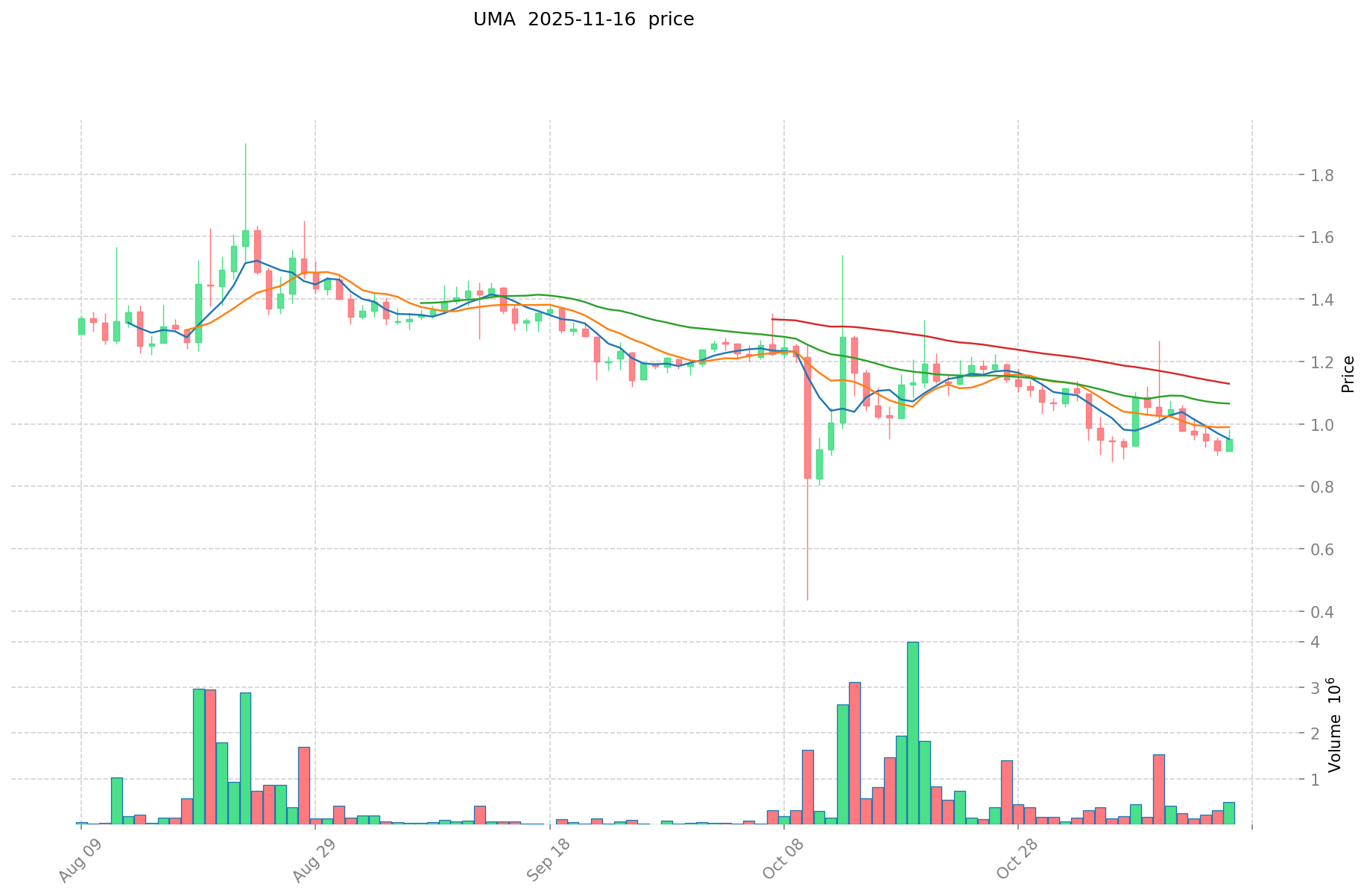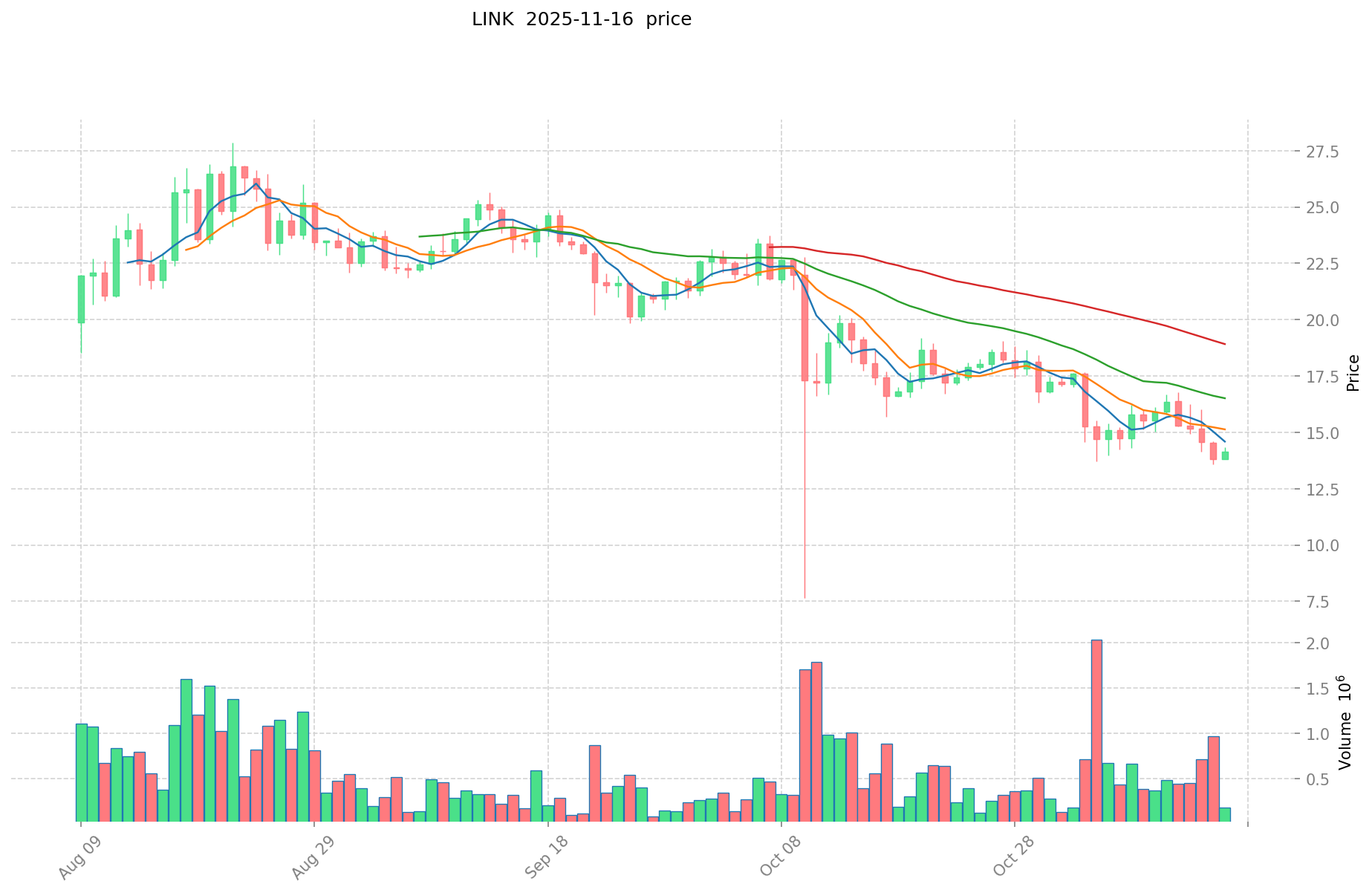UMA vs LINK: Which Oracle Solution Will Dominate the Blockchain Market?
Introduction: UMA vs LINK Investment Comparison
In the cryptocurrency market, the comparison between UMA vs LINK has always been an unavoidable topic for investors. The two not only have significant differences in market cap ranking, application scenarios, and price performance, but also represent different positioning in crypto assets.
UMA (UMA): Since its launch in 2020, it has gained market recognition for its decentralized financial contract platform.
ChainLink (LINK): Introduced in 2017, it has been hailed as a leading oracle network, and is one of the cryptocurrencies with the highest global trading volume and market capitalization.
This article will comprehensively analyze the investment value comparison between UMA vs LINK, focusing on historical price trends, supply mechanisms, institutional adoption, technological ecosystems, and future predictions, attempting to answer the question investors care about most:
"Which is the better buy right now?"
I. Price History Comparison and Current Market Status
UMA and LINK Historical Price Trends
- 2021: UMA reached its all-time high of $41.56 on February 4, 2021.
- 2021: LINK hit its all-time high of $52.7 on May 10, 2021, during the bull market.
- Comparative analysis: In the current market cycle, UMA has fallen from its all-time high of $41.56 to $0.9044, while LINK has dropped from $52.7 to $13.655.
Current Market Situation (2025-11-17)
- UMA current price: $0.9044
- LINK current price: $13.655
- 24-hour trading volume: UMA $278,164.995314 vs LINK $5,533,662.67283
- Market Sentiment Index (Fear & Greed Index): 10 (Extreme Fear)
Click to view real-time prices:
- Check UMA current price Market Price
- Check LINK current price Market Price


II. Core Factors Affecting UMA vs LINK Investment Value
Supply Mechanism Comparison (Tokenomics)
- UMA: Fixed supply of 100 million tokens with full circulation
- LINK: Maximum supply of 1 billion tokens with approximately 538 million in circulation
- 📌 Historical Pattern: LINK's gradual token release provides more controlled supply inflation compared to UMA's fully circulated supply, potentially offering different price stability characteristics.
Institutional Adoption and Market Applications
- Institutional Holdings: Chainlink has secured significantly more institutional partnerships and integrations (1000+ projects) compared to UMA
- Enterprise Adoption: Chainlink is utilized by major enterprises like Google Cloud, Swift, and AWS for oracle services, while UMA has more limited enterprise implementation
- National Policies: Regulatory bodies have shown more recognition of Chainlink's oracle services as critical infrastructure, while UMA faces similar regulatory uncertainty as other DeFi protocols
Technical Development and Ecosystem Building
- UMA Technical Upgrades: Focuses on optimistic oracle systems and financial contracts with emphasis on risk management
- LINK Technical Development: Implementing Cross-Chain Interoperability Protocol (CCIP), Chainlink Functions, and expanding price feeds across multiple blockchain networks
- Ecosystem Comparison: Chainlink has broader adoption across DeFi, NFT marketplaces, and enterprise systems with oracle services integrated into most major protocols; UMA's ecosystem is primarily centered around its optimistic oracle and derivatives contracts
Macroeconomic Factors and Market Cycles
- Inflation Environment Performance: LINK demonstrates stronger resilience during market volatility due to its widespread utility and enterprise adoption
- Macroeconomic Monetary Policy: Both tokens show correlation to broader crypto market trends, but LINK's essential infrastructure role may provide more stability during economic downturns
- Geopolitical Factors: Chainlink's decentralized oracle network provides critical infrastructure that may see increased demand during periods of economic uncertainty
III. 2025-2030 Price Prediction: UMA vs LINK
Short-term Prediction (2025)
- UMA: Conservative $0.78-$0.90 | Optimistic $0.90-$1.21
- LINK: Conservative $11.64-$13.70 | Optimistic $13.70-$17.67
Mid-term Prediction (2027)
- UMA may enter a growth phase, with expected price range of $0.71-$1.70
- LINK may enter a consolidation phase, with expected price range of $13.47-$21.19
- Key drivers: Institutional capital inflow, ETF, ecosystem development
Long-term Prediction (2030)
- UMA: Base scenario $1.47-$1.84 | Optimistic scenario $1.84-$2.67
- LINK: Base scenario $25.00-$25.78 | Optimistic scenario $25.78-$33.00
Disclaimer
UMA:
| 年份 | 预测最高价 | 预测平均价格 | 预测最低价 | 涨跌幅 |
|---|---|---|---|---|
| 2025 | 1.210556 | 0.9034 | 0.776924 | 0 |
| 2026 | 1.22609448 | 1.056978 | 0.53905878 | 16 |
| 2027 | 1.7008889976 | 1.14153624 | 0.7077524688 | 26 |
| 2028 | 1.790727899688 | 1.4212126188 | 1.165394347416 | 57 |
| 2029 | 2.07170163442476 | 1.605970259244 | 1.204477694433 | 77 |
| 2030 | 2.666312122909851 | 1.83883594683438 | 1.471068757467504 | 103 |
LINK:
| 年份 | 预测最高价 | 预测平均价格 | 预测最低价 | 涨跌幅 |
|---|---|---|---|---|
| 2025 | 17.67171 | 13.699 | 11.64415 | 0 |
| 2026 | 20.23410795 | 15.685355 | 10.0386272 | 14 |
| 2027 | 21.1924831405 | 17.959731475 | 13.46979860625 | 31 |
| 2028 | 25.2531784269975 | 19.57610730775 | 12.920230823115 | 43 |
| 2029 | 29.139035727585875 | 22.41464286737375 | 17.03512857920405 | 64 |
| 2030 | 32.99435430077416 | 25.776839297479812 | 25.003534118555418 | 88 |
IV. Investment Strategy Comparison: UMA vs LINK
Long-term vs Short-term Investment Strategies
- UMA: Suitable for investors focused on DeFi innovation and financial contract platforms
- LINK: Suitable for investors seeking essential infrastructure exposure and enterprise adoption
Risk Management and Asset Allocation
- Conservative investors: UMA: 20% vs LINK: 80%
- Aggressive investors: UMA: 40% vs LINK: 60%
- Hedging tools: Stablecoin allocation, options, cross-currency portfolios
V. Potential Risk Comparison
Market Risk
- UMA: Higher volatility due to smaller market cap and less liquidity
- LINK: Potential overvaluation risk due to high market expectations
Technical Risk
- UMA: Scalability, network stability
- LINK: Oracle network reliability, smart contract vulnerabilities
Regulatory Risk
- Global regulatory policies may have differing impacts on both tokens, with DeFi platforms potentially facing more scrutiny
VI. Conclusion: Which Is the Better Buy?
📌 Investment Value Summary:
- UMA advantages: Innovative DeFi contracts, potential for high growth in expanding DeFi sector
- LINK advantages: Widespread adoption, essential infrastructure role, strong institutional partnerships
✅ Investment Advice:
- New investors: Consider LINK for its more established position and lower volatility
- Experienced investors: Balanced portfolio with both LINK and UMA, adjusting based on risk tolerance
- Institutional investors: Focus on LINK for its enterprise-grade solutions and broader market acceptance
⚠️ Risk Warning: Cryptocurrency markets are highly volatile. This article does not constitute investment advice. None
VII. FAQ
Q1: What are the main differences between UMA and LINK? A: UMA is a decentralized financial contract platform, while LINK is a leading oracle network. UMA has a fixed supply of 100 million tokens, whereas LINK has a maximum supply of 1 billion tokens. LINK has significantly more institutional partnerships and integrations compared to UMA.
Q2: Which token has performed better historically? A: LINK has generally shown better performance. It reached its all-time high of $52.7 in May 2021, while UMA's all-time high was $41.56 in February 2021. Currently, LINK is trading at $13.655, while UMA is at $0.9044.
Q3: How do their ecosystems compare? A: Chainlink (LINK) has a broader ecosystem, with adoption across DeFi, NFT marketplaces, and enterprise systems. Its oracle services are integrated into most major protocols. UMA's ecosystem is primarily centered around its optimistic oracle and derivatives contracts.
Q4: What are the long-term price predictions for UMA and LINK? A: By 2030, UMA is predicted to reach between $1.47 and $2.67 in optimistic scenarios. LINK is expected to reach between $25.00 and $33.00 in the same timeframe.
Q5: Which token is considered a better investment for new investors? A: LINK is generally considered a better option for new investors due to its more established position, lower volatility, and widespread adoption in the crypto ecosystem.
Q6: What are the main risks associated with investing in UMA and LINK? A: For UMA, risks include higher volatility, scalability issues, and potential regulatory scrutiny of DeFi platforms. For LINK, risks include potential overvaluation, oracle network reliability, and smart contract vulnerabilities.
Q7: How should investors allocate their portfolio between UMA and LINK? A: Conservative investors might consider allocating 20% to UMA and 80% to LINK, while more aggressive investors might opt for a 40% UMA and 60% LINK split. The exact allocation should be based on individual risk tolerance and investment goals.
Share
Content